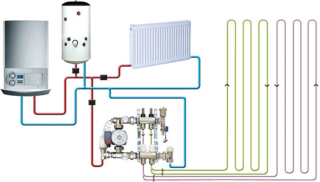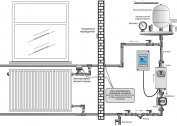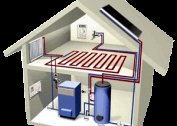"Warm floor or radiator heating?". This question today is asked by many advanced private developers who are “lucky” to build their homes in the context of the crisis of recent years, which taught them to think carefully about any purchases, especially those that are serious, such as a heating system. It is unlikely that choosing the appropriate heating method from the two above methods without first studying the topic and analyzing the market, because each of them has both advantages and disadvantages that somehow limit the area of rational use. How to choose a method and circuit diagram for heating a private house will be discussed in this article.
Since the level of the current stage of development of individual construction in Russia does not allow making competent and balanced engineering decisions on its basis, when choosing a suitable heating system for a newly built house, we are forced to copy the experience of more successful European countries in this area. So, let's see how our closest neighbors such as Germany, Finland, Norway and Sweden approach the organization of heating low-rise apartment buildings today. The climatic conditions of these countries practically do not differ from ours, which means that the engineering solutions that work effectively for them, with a high degree of probability, will work just as effectively with us.
Private house heating in Europe today
 The research results were quite interesting. It was found that in Germany, and in all of these Scandinavian countries in low-rise buildings, the same trends and heating technologies are popular. So, approximately 95% of the total volume of single-family residential buildings put into operation in a year in these countries have a mixed (combined) heating system, which is a combination of underfloor heating and classic radiator heating, operating in parallel. The simultaneous use of two heat sources at home, as it turned out, justifies the high efficiency of this solution, providing thermal comfort and at the same time contributing to energy savings. The principle of mixed heating of houses is indecently simple.
The research results were quite interesting. It was found that in Germany, and in all of these Scandinavian countries in low-rise buildings, the same trends and heating technologies are popular. So, approximately 95% of the total volume of single-family residential buildings put into operation in a year in these countries have a mixed (combined) heating system, which is a combination of underfloor heating and classic radiator heating, operating in parallel. The simultaneous use of two heat sources at home, as it turned out, justifies the high efficiency of this solution, providing thermal comfort and at the same time contributing to energy savings. The principle of mixed heating of houses is indecently simple.
A key role is given to the underfloor heating system, which ensures even distribution of heat in the rooms. In turn, the radiators have the task of enhancing the resulting thermal effect, thereby contributing to maintaining a constant comfortable temperature in the house. The heat generated by the warm floor evenly spreads over the entire area of the room and during cooling, rises up to the ceiling. In turn, the heat vector generated by the radiators is directed in the opposite direction, i.e. tends to the floor. Thus, the efficiency of this heating system is based on the mutually opposite direction of the distribution of heat generated by each of the two sources.
Now let's look at specific schemes by which a mixed home heating system can be implemented.
Schemes of mixed heating of individual houses
Scheme No. 1: “Warm floor below, radiators above”
 The most common way to implement a mixed heating system for low-rise residential buildings in Europe is a scheme in which underfloor heating is arranged on the lower floor, and radiators on the upper. This solution is ideal for homes that include a spacious two-light room.
The most common way to implement a mixed heating system for low-rise residential buildings in Europe is a scheme in which underfloor heating is arranged on the lower floor, and radiators on the upper. This solution is ideal for homes that include a spacious two-light room.
When implementing this scheme, in the rooms of the second floor located near the stairs, as well as in rooms with very high ceilings, warm air can be concentrated only at the floor level within a height of 30-50 cm from its final surface. Those. only the legs of a person will be warm, which is clearly not enough to ensure thermal comfort. In other words, in such a room a person will be quite cold in the winter season. Do not forget about this when planning home heating according to the specified scheme.
In some rooms, the thermal floor system is arranged by definition, regardless of what floor it is located on. We are talking about bathrooms, halls (at the entrance), kitchens, dining rooms - i.e. where ceramic tiles are used as the final flooring. One heat-insulated floor will be enough to heat the entire first floor, provided that the house is properly insulated and built in accordance with modern energy efficiency standards. In houses in which the entire second floor is reserved for the sleeping area, in most cases there is enough radiator heating.
Radiator heating is preferable to use in those rooms that are not used throughout the day, for example, in bedrooms. As a rule, bedrooms are much smaller than other rooms and a comfortable thermal regime in them can be created in a relatively short period of time before going to bed.
It should be noted that radiators are more effective than underfloor heating in rooms with parquet floors, as well as in the presence of floor carpets in the room, which prevent heat leakage from the room.
Scheme No. 2: “Heat-loving interior”
The second less popular method of mixed heating of residential buildings is that underfloor heating and radiators are located in all heated areas of the house. It is easy to guess that the implementation of this scheme will be much more expensive than the first, but in some cases it is simply impossible to solve the heating problem in any other way. The simultaneous use of underfloor heating and radiators justifies itself in houses with unique architectural and planning solutions - large panoramic or balcony windows, glazed terraces, conservatories, stained glass windows and any other forms of facade glazing.


